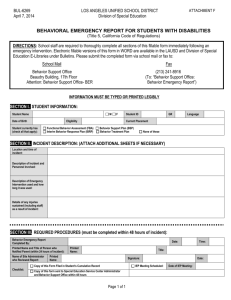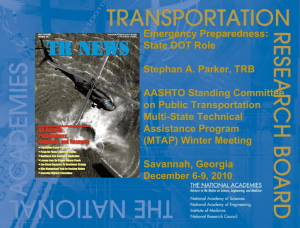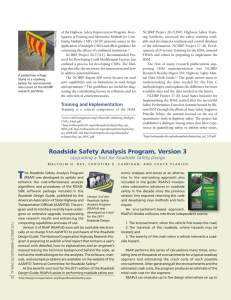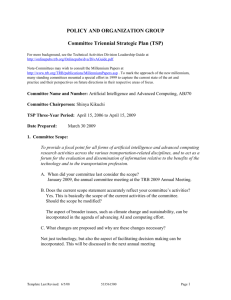Research Needs Assessment for Roadside Worker and Vehicle
advertisement
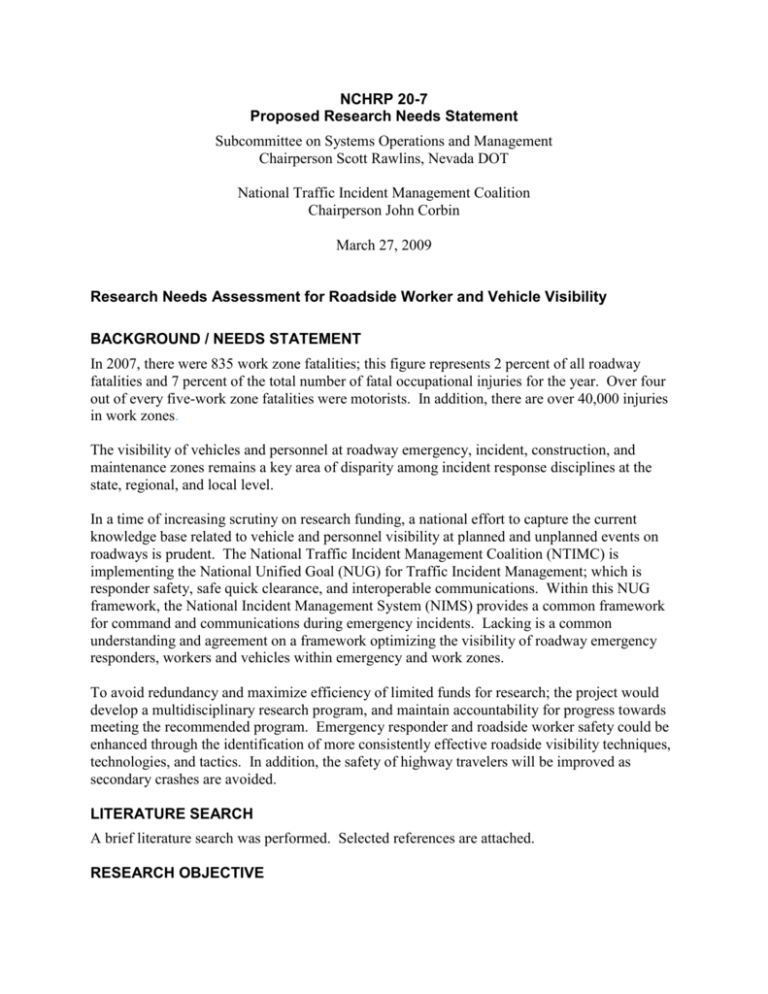
NCHRP 20-7 Proposed Research Needs Statement Subcommittee on Systems Operations and Management Chairperson Scott Rawlins, Nevada DOT National Traffic Incident Management Coalition Chairperson John Corbin March 27, 2009 Research Needs Assessment for Roadside Worker and Vehicle Visibility BACKGROUND / NEEDS STATEMENT In 2007, there were 835 work zone fatalities; this figure represents 2 percent of all roadway fatalities and 7 percent of the total number of fatal occupational injuries for the year. Over four out of every five-work zone fatalities were motorists. In addition, there are over 40,000 injuries in work zones. The visibility of vehicles and personnel at roadway emergency, incident, construction, and maintenance zones remains a key area of disparity among incident response disciplines at the state, regional, and local level. In a time of increasing scrutiny on research funding, a national effort to capture the current knowledge base related to vehicle and personnel visibility at planned and unplanned events on roadways is prudent. The National Traffic Incident Management Coalition (NTIMC) is implementing the National Unified Goal (NUG) for Traffic Incident Management; which is responder safety, safe quick clearance, and interoperable communications. Within this NUG framework, the National Incident Management System (NIMS) provides a common framework for command and communications during emergency incidents. Lacking is a common understanding and agreement on a framework optimizing the visibility of roadway emergency responders, workers and vehicles within emergency and work zones. To avoid redundancy and maximize efficiency of limited funds for research; the project would develop a multidisciplinary research program, and maintain accountability for progress towards meeting the recommended program. Emergency responder and roadside worker safety could be enhanced through the identification of more consistently effective roadside visibility techniques, technologies, and tactics. In addition, the safety of highway travelers will be improved as secondary crashes are avoided. LITERATURE SEARCH A brief literature search was performed. Selected references are attached. RESEARCH OBJECTIVE The objective of this research is to develop: a multidisciplinary, national research program to develop a framework for visibility of roadway emergency responders, workers and vehicles within emergency and work zones similar to the existing NUG framework for command and communications, a research implementation roadmap, plan and schedule to develop the framework, research project accountability tracking methods and measures for achieving the framework. WORK TASKS Tasks anticipated in this project include the following: 1. Literature review and synthesis of completed and active research on visibility of vehicles and personnel at construction, maintenance, and emergency scenes. Human factors research for workzones should be included. 2. Develop a strawman research roadmap and program for roadside worker, responder safety, and conspicuity. 3. Conduct a 1-2 day workshop to identify gaps, needs, and opportunities within the strawman. 4. Summarize a final research roadmap and program to guide efforts within NCHRP, SHRP2, USFA, as well as state, regional, and local research programs. Follow on. Complete 1-year and 2-year implementation status reports within SSOM leadership and the NTIMC to maintain accountability for progress. URGENCY Completion of this research will allow for effective and coordinated use of SHRP2, NCHRP, and USFA funds allocated for use over the next few years. The NTIMC and the NUG provide mechanisms by which multidisciplinary incident response stakeholders have agreed collaborate; a coordinated research agenda and measures of accountability will take advantage of the recent momentum gained. FUNDING REQUESTED AND TIME REQUIRED It is estimated that this research will take 9 months to complete and will require $90,000. Task/Month 1 2 3 4 May June July Project Timeline Aug Sept Oct Nov Dec Jan Feb Mar April CONTACT PERSONS John Corbin Bureau of Highway Operations 4802 Sheboygan Avenue Madison, WI 53707-7986 608-266-0459 John.corbin@dot.state.wi.us Brett Graves 1710 SAIC Drive M/S T1-12-3 McLean, VA, 22102 703-676-6794 Brett.o.graves@saic.com Larry Orcutt California Department of Transportation P.O. Box 942873 Sacramento, CA, 94273-0001 916-654-8877 larry_orcutt@dot.ca.gov Selected Results of Literature Search Graham, J. L., Migletz, J., Loumiet, J. R., Hinch, J., Stout, D., and Lerner, N. (Unpublished) Maintenance Work Zone Safety. Available at http://onlinepubs.trb.org/Onlinepubs/shrp/SHRP89-001.pdf Stout, D., Graham, J., Bryant-Fields, B., Migletz, J., Fish, J., Hanscom, F. (1993) Maintenance Work Zone Safety Devices Development and Evaluation. Available at http://onlinepubs.trb.org/Onlinepubs/shrp/SHRP-H-371.pdf MacLeod, E. N., and Chiarella, M. (1994) Automated Vehicle for Enhanced Work Crew Safety. Available at http://onlinepubs.trb.org/Onlinepubs/shrp/SHRP-H-676.pdf Christianson, K., Greenhouse, D., Cohn, T., Kim, R. Y., and Chow, C., (2008). Work Zone Safety Improvements Through Enhanced Warning Signal Devices. Available at http://www.path.berkeley.edu/PATH/Publications/PDF/PRR/2008/PRR-2008-03.pdf Arditi, D., Shi, J., Ayrancioglu, M., and Lee, D-E. (2003) Nighttime Construction: Evaluation Of Worker Safety Issues. Illinois Institute of Technology. Available at http://ntl.bts.gov/lib/24000/24800/24804/VD-H2_FY00_01.pdf Bryden, J. E., and Mace, D. (2002) NCHRP Report 476, “Guidelines for Design and Operation of Nighttime Traffic Control for Highway Maintenance and Construction.” Washington, DC: TRB, National Academics. Available at http://trb.org Sant, Brad (May-June 2007) High-Tech Work Zones. Transportation Builder Vol.19 No.3. P.1316 Hass, Karen (2006) Example Strategies for Building Stronger State Traffic Incident Management Programs. National Traffic Incident Management Coalition. Available at http://www.transportation.org/sites/ntimc/docs/Institutional%20Models.pdf








